Wastewater treatment stations. Biological wastewater treatment in a private home: principle of operation, pros and cons, comparison, reviews
3Autonomous sewerage system "Unilos" is another solution for the protection aquifers and soils with domestic wastewater.
This is a newly developed deep biological treatment station Wastewater up to 98%.
The industry currently produces many similar cleaning structures suitable for installation on suburban areas and dachas.
The Unilos Astra septic tank operates automatically and does not require human intervention.
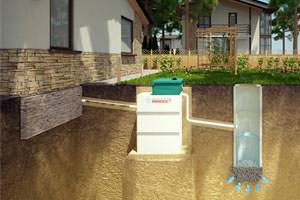 A septic tank works like this:
A septic tank works like this:
- First, wastewater enters the receiving chamber, where, under the pressure of air coming from below, it is mixed and clarified.
- Water that has undergone preliminary clarification, under the action of an airlift, enters an aeration tank, in which, under the influence of oxygen constantly supplied there, it is purified by activated sludge.
- The Unilos Astra septic tank uses an intermittent aeration method, which helps to effectively remove nitrates from wastewater.
- The secondary settling tank serves to sediment suspended activated sludge.
- With the help of an airlift, the sludge that precipitates falls into a sludge settling tank, where clean water is discharged out.
The advantages of the Unilos treatment system are as follows:
- Low cost and convenient septic tank integration.
- Wastewater treatment is fully automated.
- Low power consumption.
- High tightness ensures the absence of unpleasant odors.
- Long service life.
- Aesthetics.
For country houses most often used wastewater treatment plants Unilos "Scarab", "Cyclone" and "Astra".
They are equipped with tanks that allow the treatment of 0.6-30 m 3 of wastewater, and work perfectly when processing wastewater into residential buildings with a number of residents from 3 to 150 people.
How to choose a model
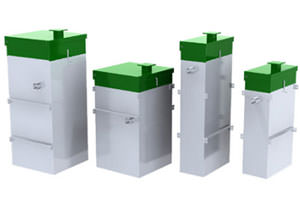 Let's consider the septic tanks Unilos Astra 3 and Unilos Astra 5.
Let's consider the septic tanks Unilos Astra 3 and Unilos Astra 5.
The number at the end of the model designation indicates the number of people for which the treatment system is designed.
The price of a Unilos septic tank increases with the number of residents of the house.
If we compare the most popular models, we get the following:
- Septic tank Unilos Astra 3 is considered the most compact treatment station with not very high power, suitable for work in a small or medium area country house, in which three people live.
- Septic tank Unilos Astra 5 represents the optimal combination of price and power. Works most effectively in a house with five residents.
- Conduct visual inspection of wastewater once a week.
- Remove sludge from tanks and settling tanks once every 3 months
- Once every 3 months, clean the mamut pump, filters, blower and hair catcher.
Correct and high-quality maintenance can only be carried out by trained personnel.
But you can independently carry out the required procedures for maintaining the station if all requirements are strictly observed.
Station maintenance - how to remove sludge
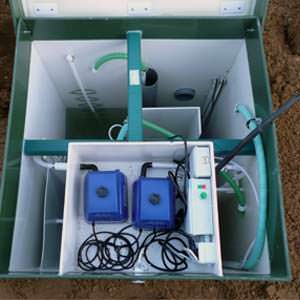 The Unilos Astra local treatment plant does not require special skills for its maintenance - it is simply necessary to remove excess activated sludge from time to time.
The Unilos Astra local treatment plant does not require special skills for its maintenance - it is simply necessary to remove excess activated sludge from time to time.
To find out whether it is time to remove sludge from the septic tank or not, you need to know during what time period sludge forms in the tank.
After the first start-up, sludge accumulates within 30-40 days.
Newly formed silt is brown in color. After 10-15 days, the purified water becomes better and cleaner.
How longer time the work of the Unilos septic tank, the thicker and darker the sludge becomes, and at the outlet the water becomes clean and not without foreign odors.
How is sludge pumped out?
There are certain rules according to which water is pumped only from the stabilizer. Water is pumped out of the Unilos septic tank using a mamut pump, and pumping proceeds as follows:
- The switches on the control unit must be installed in the following order: “COMPR.” — “0”, “MANUAL” — “1”, “REV.” - “0”.
- Then you need to wait 25-40 minutes and remove the plug on the sludge stabilizer and on the mamut pump hose.
- Then the “COMPR.” switch is set to position “1”.
- After this, pumping of sludge into the prepared container begins.
- Inside the septic tank it is necessary to leave half the volume of liquid in it.
- At the end of pumping, the “COMPR.” switch and the “MANUAL” switch you need to set the position to “0”.
- The plug on the mamut pump hose must be replaced.
- Fill the septic tank compartment with water up to the green marks on the walls.
Such procedures must be performed once every 3 months.
There is another method of pumping sludge to Unilos:
- On the control unit, the “Valve” and “Compressor” switches must be set to position “0”.
- Using a drainage pump, completely pump out the sludge from the container. To do this, the pump must be placed in a sludge stabilizer tank.
- After pumping out, fill the container completely clean water evenly to the green marks on the walls.
- Upon completion of all operations, set the “Valve” and “Compressor” switches to position “1”.
These procedures for the Unilos septic tank can be carried out once every 6 months.
Price
Price model range Unilos septic tanks are directly proportional to their performance and terms of sale. Inexpensive Unilos models have a capacity designed for 3-5 residents.
With the help of the most expensive treatment plants, you can equip general sewerage for several residential buildings with a total number of residents up to 150 people.

If you order a septic tank with turnkey installation, the cost of delivery and installation is reduced accordingly.
The approximate cost of the most popular septic tanks as of 20134 is shown in the table below.
Each of us cannot imagine our life without simple but necessary amenities in own home: water, electricity, gas. This applies not only to city residents - owners of private houses, cottages and summer cottages also choose comfort and are increasingly installing autonomous systems sewerage, heating, water supply. These solutions require competent design and a qualified approach.
Thus, of particular importance when installing individual sewer system has a problem with storage, treatment and disposal of wastewater. Often it is solved, as they say, the old fashioned way - they equip a cesspool and periodically empty it using a sewer truck. However, this is not always convenient: the pit requires constant monitoring, high-quality insulation winter period, and over time it collapses, needs repairs or becomes completely unusable. In addition, cesspools and septic tanks can cause significant damage to the environment and are not optimal solution from a hygienic point of view, especially if they are located next to a well from which water enters the house. Today there are more effective method solving the problem of wastewater treatment and disposal, than cesspool and septic tanks. This is an autonomous deep station biological treatment(SGBO), otherwise called an aeration tank.
The main difference between a deep biological treatment station and a septic tank is its efficiency. Water that has undergone filtration does not require additional purification in filtration fields or in filtration wells; it can be safely discharged into a nearby ravine, reservoir or into the ground. If the aeration tank has a disinfection system, the purified water can even be reused, for example, for watering the garden and other agricultural needs. In addition, when proper operation The wastewater from the installation does not emit an unpleasant odor.
The operating principle of modern stations combines mechanical and biological methods of wastewater treatment. In the first compartment, as a rule, sand and other insoluble contaminants are filtered out, and at the next stage the water undergoes biological treatment. It is worth noting that water flows between the compartments not through a pump, but with the help of air bubbles, which are usually pumped by a compressor. All this creates a favorable environment for aerobic bacteria, which absorb human waste products from wastewater, purifying them by 97-99%. As a result, dark brown sludge remains at the bottom of the container, has no odor and does not pose a danger to the environment.
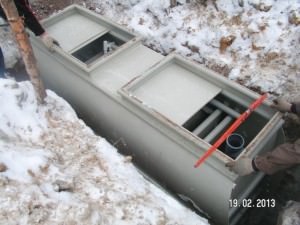 Modern manufacturers offer huge selection deep biological treatment stations, and choice desired installation must take into account several factors:
Modern manufacturers offer huge selection deep biological treatment stations, and choice desired installation must take into account several factors:
The number of people living in the house.
“Seasonality” of use of the sewerage system.
Maximum volley discharge of wastewater into the sewer system. This indicator indicates how much water the sewer system receives from sinks, toilets, bathtubs and other drainage points at the same time.
In general, you can be guided by simple statistics, according to which each person on average consumes about 200 liters of water daily. It turns out that with regular use of water supply for a family of 5 people, you need to choose a biological treatment station with a volume of 1000 liters.
As for the number of chambers that make up the installation, the optimal solution for a private house, summer house or small cottage would be an aeration tank consisting of 3 sections. For the mansion and big house You can choose a four-chamber system.
So, the installation has been selected, let's begin installation. First you need to decide on the place where the aeration tank will be installed and dig a pit. According to general requirements, the station should be located no closer than 8 meters to the sewage facility and the well from which clean water flows into the house. We fill the bottom of the pit with a sand-cement mixture about 0.2 meters high, and then dig a pit for the pipeline based on a pipe with a diameter of at least 110 mm. The station must be installed on a sand-cement bed as carefully as possible, strictly horizontal position. Then manually tamp down all the sinuses and seals and pour water to fill them better.
The correct location of the biological treatment system is the key to its long and uninterrupted operation. Special attention you need to pay attention to installing it. For example, many modern stations do not require anchoring, as they have special devices - so-called bottom lugs. In other cases, the aeration tank is installed on concrete base, “anchored” with concrete slabs, anchor straps or other methods. These measures will make the aeration tank resistant to displacement, which may be caused by freezing of groundwater or its mobility.
The next stage of work is the internal filling of the installation compartments - if necessary, expanded clay, crushed limestone and other materials are filled in, and garlands are mounted on metal or plastic pins. When these steps are completed, the station is filled with water up to the level of the weirs.
In regions with long winters and severe frosts It is worth taking care of the insulation of the station. This can be done in two ways: firstly, the installation itself must be located below the freezing level of the soil, and secondly, the pit must be made slightly wider than the aeration tank. This will make it possible to take additional measures to insulate the biological treatment plant. Most often, an electric heating cable is used for this.
The last stage in the installation of the entire system is the installation of pipes and additional equipment (compressor, disinfection units).
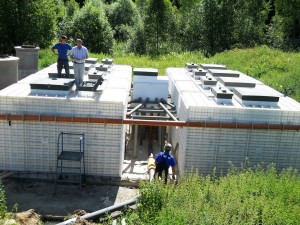 After installation, the sewage water treatment plant is launched. The first thing to consider is correct setting aeration. It is important to understand that in aeration tanks the main work is performed by aerobic bacteria, which intensively consume oxygen. That is why the gas pumping system requires the installation of a compressor that continuously pumps oxygen into the system. This determines the high degree of wastewater purification and the speed of this process. Here lies one of the disadvantages of using aeration tanks - if the compressor fails, all active aerobic bacteria will die, and restoration of the microflora will take at least a month. Let us add that other disadvantages of a biological treatment plant are more high price, compared to a conventional septic tank and energy costs. However, all the disadvantages of using these installations are compensated by their advantages described above.
After installation, the sewage water treatment plant is launched. The first thing to consider is correct setting aeration. It is important to understand that in aeration tanks the main work is performed by aerobic bacteria, which intensively consume oxygen. That is why the gas pumping system requires the installation of a compressor that continuously pumps oxygen into the system. This determines the high degree of wastewater purification and the speed of this process. Here lies one of the disadvantages of using aeration tanks - if the compressor fails, all active aerobic bacteria will die, and restoration of the microflora will take at least a month. Let us add that other disadvantages of a biological treatment plant are more high price, compared to a conventional septic tank and energy costs. However, all the disadvantages of using these installations are compensated by their advantages described above.
Second important aspect When starting a wastewater treatment system, microflora is inoculated. The fact is that aerobes that clean sewage live in human waste and appear only after the first use of a biological treatment station. However, at the beginning of the aeration tank’s operation, their number will be minimal, and it will be impossible to achieve water purification to the 99% declared by the manufacturer. This result can only be achieved after 4-8 weeks of regular use of the system. Today there is a great opportunity speed up this process by 2-3 times. For these purposes, preserved bacteria developed by biotechnologists are used. Sowing microflora will allow you to restore the population of aerobic bacteria to the desired level in just a couple of weeks.

With proper and careful operation, an autonomous sewage treatment station serves long years, however, there are a number of rules that will help extend the life of its operation in trouble-free mode.
Firstly, a good owner must take into account volley discharges not only when installing the system, but also during its operation. The highest water consumption is shown by the corner bath and Jacuzzi bath. Their figure, according to the standards, is about 450 liters. For comparison: regular bath has a corresponding indicator of 220 l, shower - 100 l, sink - 20 l, and toilet - 10 l. Accordingly, if a corner bathtub, a toilet bowl and a kitchen faucet simultaneously drain water in a house, then the volley discharge into the treatment system will be about 480 liters in volume, and this indicator must be taken into account when choosing and operating a wastewater treatment plant.
Secondly, the second important aspect when operating a station is its restoration after long downtime. This is especially true in dachas, where the water supply system is used seasonally and not all year round. Strictly speaking, in houses with seasonal residence, installing an aeration tank in itself is impractical, since in the absence of organic waste Aerobes are deprived of food and simply die. Restoring microflora, as already mentioned above, is a rather troublesome and expensive matter. In this case, it is better to opt for a conventional septic tank, so the invested money and effort will be justified. If, for some reason, the deep biological treatment station is inactive, be patient and restore its operation. For this purpose, preserved bacteria are usually used, which will quickly bring the number of aerobes to the required level and, accordingly, speed up the process of restoring the entire system, and you will again be able to use the wastewater treatment station as usual.
The third aspect that needs to be paid attention to when maintaining the system is pumping out activated sludge. Activated sludge is a biomass suspended in water that carries out the purification process. Excess organic matter, entering the aeration tank with wastewater, and a large amount of oxygen promote the proliferation of bacteria that form flocculent substances Brown and size 4-5 mm. Over time, activated sludge mineralizes and forms in the form of high-density bottom sediment, which does not in the best possible way affects water purification: aerobic bacteria remain in dense bottom sediment, acting only on the surface. To do this, it is recommended to pump out activated sludge from the aeration tank several times a year.
Let's sum it up
An autonomous deep biological treatment station is the optimal solution for anyone who wants to establish uninterrupted operation of water supply and sewerage systems in a private home, country cottage or on a summer cottage. Right choice, high-quality installation, careful operation and constant monitoring of the operation of the aeration tank will solve the problem of wastewater treatment and disposal and will become a successful investment.




